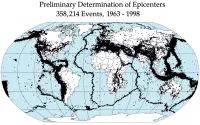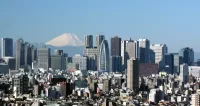The Nikkei 225 is a price-weighted stock market index for the Tokyo Stock Exchange (TSE), measuring the performance of 225 highly capitalized and liquid Japanese companies across diverse sectors. Operating in Japanese Yen (JP¥), the index is reviewed bi-annually and calculated every five seconds since 2017. Originally launched in 1950 by the TSE, the Nihon Keizai Shimbun newspaper assumed responsibility in 1970 after the exchange shifted its focus to the market capitalization-weighted TOPIX (Tokyo Stock Price Index). The Nikkei 225 serves as a key indicator of the Japanese stock market and economy.
1914: Nikkei 225 Calculated Back to 1914
The annual development of the Nikkei 225, which was calculated back to 1914.
May 1949: Nikkei 225 Retroactive Calculation
The Nikkei 225 was retroactively calculated back to May 16, 1949, when the average price of its component stocks was 176.21 yen.
September 1950: Nikkei 225 Calculation Begins
On September 7, 1950, the Nikkei 225 began to be calculated.
1982: Nikkei at Lowest Year-End Closing Value Since 1982
In 2011, the Nikkei fell over 17%, finishing the year at 8,455.35, its lowest year-end closing value since 1982, when the index finished at 8,016.70.
1986: Nikkei 225 Futures Introduced at Singapore Exchange
In 1986, the Nikkei 225 Futures were introduced at the Singapore Exchange (SGX).
1987: Nikkei surpassed 1987's Black Monday
On August 5, 2024, amid a global stock market decline, the Nikkei dropped by more than 4,200 points, surpassing 1987's Black Monday as its biggest single-day drop in history.
1988: Nikkei 225 Futures Introduced at Osaka Securities Exchange
In 1988, the Nikkei 225 Futures were introduced at the Osaka Securities Exchange (OSE).
December 1989: Nikkei Reaches Bubble-Era Record High
On December 29, 1989, the Nikkei hit its bubble-era record high, reaching an intraday high of 38,957.44 before closing at 38,915.87.
1989: Nikkei reaches record high
The Nikkei reached its record high in 1989 during the Japanese asset price bubble.
1990: Nikkei 225 Futures Introduced at Chicago Mercantile Exchange
In 1990, the Nikkei 225 Futures were introduced at the Chicago Mercantile Exchange (CME).
October 2008: Nikkei Reaches Post-Bubble Intraday Low
On October 28, 2008, the Nikkei reached a post-bubble intraday low of 6,994.90, which was 82% below its peak nearly 19 years earlier.
March 2009: Nikkei at Lowest Close Since March 2009
On November 25, 2011, the Nikkei bottomed out at 8,160.01, putting it at its lowest close since March 31, 2009.
March 2011: Nikkei Drops After Earthquake
On March 15, 2011, the second working day after the massive earthquake in the northeast part of Japan, the Nikkei index dropped over 10% to finish at 8,605.15, a loss of 1,015 points.
2013: Nikkei Starts 2013 Near 10,600
The Nikkei started 2013 near 10,600, hitting a peak of 15,942 in May, before plunging by almost 10% and rebounding, making it the most volatile stock market index among the developed markets.
2015: Nikkei Reaches Over 20,000 Mark in 2015
By 2015, the Nikkei had reached over 20,000 mark, marking a gain of over 10,000 in two years, making it one of the fastest growing stock market indices in the world.
July 2017: Nikkei 225 Index Updated Every 5 Seconds
Since July 2017, the Nikkei 225 index is updated every 5 seconds during trading sessions.
2017: Bank of Japan's ETF Ownership
From a start in 2013, by end 2017, the BOJ owned circa 75% of all Japanese Exchange Traded Funds ("ETFs"), and were a top 10 shareholder of 90% of the Nikkei 225 constituents.
2017: Nikkei 225 Calculation Frequency Increased
Since 2017, the Nikkei 225 index is calculated every five seconds.
2018: Nikkei Growth More Moderate at Around 22,000 Mark in 2018
By 2018, the Nikkei index growth was more moderate, at around the 22,000 mark.
October 2023: Nikkei 225 Composition in October 2023
As of October 2023, the Nikkei 225 consists of specific companies identified by their Japanese securities identification code.
February 2024: Nikkei Surpasses 1989 Record High
On February 22, 2024, the Nikkei reached an intraday high of 39,156.97 and closed at 39,098.68, finally surpassing its 1989 record high.
March 2024: Nikkei Surpasses 40,000 for the First Time
On March 4, 2024, the Nikkei surpassed 40,000 (intraday and closing) for the first time in history.
July 2024: Fast Retailing Has Largest Influence on Nikkei 225
As of July 2024, Fast Retailing (TYO: 9983) has the largest influence on the Nikkei 225 index, at about 10% weight.
August 2024: Nikkei Experiences Biggest Single-Day Drop and Gain
On August 5, 2024, amid a global stock market decline, the Nikkei dropped by more than 4,200 points, surpassing 1987's Black Monday as its biggest single-day drop in history. The following day, it bounced back by more than 3,200 points, the largest single-day gain in history.
2024: Nikkei Surpasses 1989 Record High
In 2024, the Nikkei surpassed its 1989 record high after 34 years.
Mentioned in this timeline

The stock market is a platform where buyers and sellers...
Japan is an East Asian island country in the Pacific...

An earthquake is the shaking of the Earth's surface caused...

Tokyo the capital of Japan is a global megacity Its...

Chicago is the most populous city in Illinois and the...

Stocks are restraining devices primarily for the feet historically used...
Trending
51 minutes ago Pixel 9a Launch: $499 Price, AT&T Offerings, and Best Deals

51 minutes ago Jack Draper Advances to Third Round at Monte Carlo Masters with Victory

51 minutes ago Lizzo reveals her disappearance after scandal was planned; addresses recent silence.

2 hours ago Bogdan Bogdanovic Shines: Leads Bench in Scoring on Tuesday Night

2 hours ago USUAA Candidate Profiles: Insights into Jason Ritter's Aims for Student Government

2 hours ago Eddie Montgomery Becomes Southern Kentucky Distillery Ambassador; Warren Zeiders Releases 'Reason'
Popular

Peter Navarro is an American economist and author known for...

Bruce Pearl is an American college basketball coach currently head...
The Nintendo Switch is a video game console developed by...
Facebook is a social media and networking service created in...

LeBron James nicknamed King James is a highly decorated American...

Ubisoft Entertainment SA is a French video game publisher based...